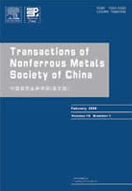Dissolution behavior of Cu in Cu−Ag and Cu−P brazing
alloys using weld brazing
(1. State Key Laboratory of Advanced Welding and Joining, Harbin Institute of Technology, Harbin 150001, China;
2. School of Mechanical Engineering, Qingdao Technological University, Qingdao 266000, China)
2. School of Mechanical Engineering, Qingdao Technological University, Qingdao 266000, China)
Abstract: The dissolution behavior of base metal Cu in the Cu−Ag and Cu−P brazing alloys using weld brazing was researched. The thickness loss of Cu foil in contact with Cu−P and Cu−Ag alloys at 800−920 °C was measured. And the dissolution rate constants in both alloys were calculated as the following relation: kCu-P(T)=10kCu-Ag(T), which explains the special phenomenon that the dissolving amount of copper in Cu-P liquid alloys is larger than that in Cu-Ag alloys under the same condition. As weld brazing has its own characteristics of short reaction time and quick temperature variation in one thermal cycle, the quick dissolution rate of copper in filler metals is the main reason to achieve weld brazing. It can be concluded that element P is indispensable in filler metals compared with element Ag as the function of accelerating dissolution during weld brazing. Finally, the influences of the addition of alloy element on mechanical performance of the welding joints were studied and the design principles of filler metals for weld brazing were proposed to achieve good mechanical performance.
Key words: weld brazing; dissolution rate; temperature distribution; mechanical performance

